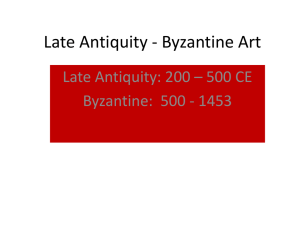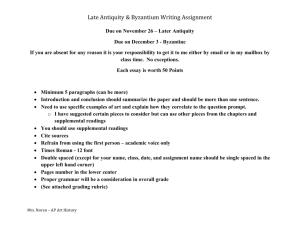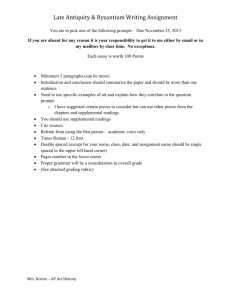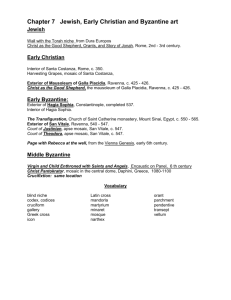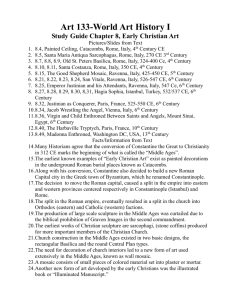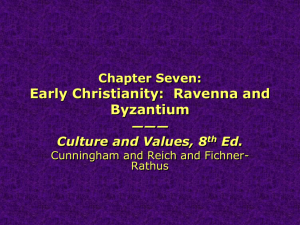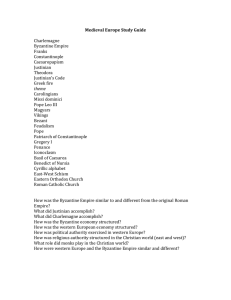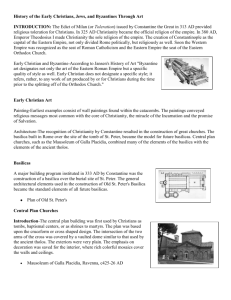images for discussion - Blue Valley School District
advertisement
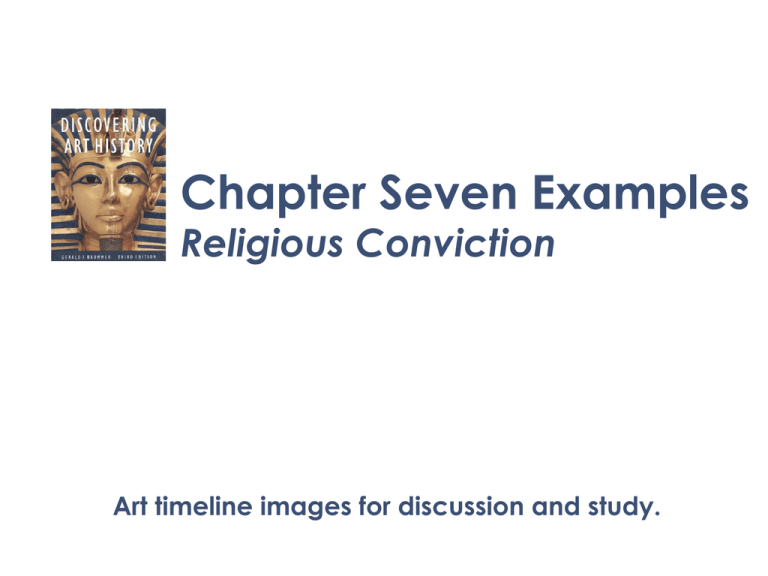
Chapter Seven Examples Religious Conviction Art timeline images for discussion and study. Faith is the substance of things hoped for, The evidence of things not seen. Hebrews, xi, i I should be able to… 7 • Explain why during the Christian era, art shifts from earlier Greek and Roman tradition or realism toward a strong use of symbols • Understand that under Justinian, the Byzantine Empire moved to the East in 527 and that the emperor was extremely influential in fostering the art of his reign. • Comprehend that during the seventh century, the rival faith of Islam, which began in Arabia, spread rapidly to the near East and the southern Mediterranean. • Describe Islamic art and explain why it relied heavily on geometric and abstract forms. • Understand that early medieval art was made by nomadic tribes until Charlemagne fostered a revival of Classican culture in the late eighth and early ninth centuries. Art History Learning Targets I should be able to… 7.1 • Explain why early Christian art used figures and images symbolically. • Understand that before Emperor Constantine made Christianity the state religion in 313, frescoes of Christian sub were painted on the ceilings and walls of secret, underground tunnel-like catacombs. • Comprehend that the legalization of Christianity gave rise to new architecture and highly crafted objects. • Describe the typical plan of an early Christian church and understand its origins in Roman basilicas. • Understand that the T-shaped basilica plan became the general basis of European churches for many centuries. Art History Learning Targets 7.1 VOCABULARY Diptych (dip-tik) rotunda (ro-tun-dah) Catacombs (kat-i-komz) sarcophagus (sar-koff-ag-gus) Atrium (ay-tree-um) Nave Apse Baldachin Transept Crypt (kript) Ivory Panel showing an Archangel (and reverse side) c. 525 – 550 Constantinople, Turkey The Good Shepherd, from the Catacomb of Saints Peter and Marcellinus, Rome 4th century Fresco Sarcophagus with Old and New Testament Scenes, Santa Maria Antiqua, Rome, Italy, c. 270. 23.25 inches by 86 inches. Marble Apollinare in Classe 533 – 549, Ravenna, Italy Apollinare in Classe (interior) 533 – 549, Ravenna, Italy Basilica floor plans St. Apollinare in Classe, 533 – 549, Ravenna, Italy floor plan Floor plan, Old St. Peters Panoramic view of interior Santa Maria Maggiori 431, Rome, Italy (Christ as) The Good Shepherd 270 – 280, Asia Minor, Phrygia (Central Turkey) Calf Bearer Greek, Early sixth century BCE Chalice of Antioch 350 – 500, Syria Silver and gilt Sarcophagus of Junius Bassus c. 359, Museo Petriano, St. Peter’s, Rome marble Church of San Vitale 525 – 547, Ravenna, Italy Christ between the Virgin and Saint John the Baptist (detail) 1261, Constantinople I should be able to… 7.2 • Understand that the Roman Empire was divided into two after the death of Constantine in 337, and Constantinople become the powerful seat of the Eastern sphere. • Describe the Golden Age of Byzantine art and culture that began under the emperor Justinian. • Describe how Byzantine art stresses symbolism over naturalism as a means of communicating spiritual ideas. • Explain that Byzantine architecture and mosaic decoration spread throughout Eastern Europe and eventually to Russia. • Comprehend that in the early eight century, a controversy disrupted the development of Byzantine culture for over 100 years as iconoclasts, who wanted to destroy religious images, fought those who felt it important to keep religious depictions. • Explain that Byzantine icons (religious images) were painted on wood panels and were used both in worship centers at home and in church interiors. Art History Learning Targets 7.2 VOCABULARY Tessera (tess-ah-rah) Pendentive (pen-den-tiv) Pier Icon (eye-kon) Iconostasis (eye-kon-ah-stah-sis) Triptych (trip-tik) Church of San Vitale (interior) 525 – 547, Ravenna, Italy The Emperor Justinian and Attendants c. 547, San Vitale, Ravenna, Italy mosaic Empress Theodora and Attendants c. 547, San Vitale, Ravenna, Italy mosaic Hagia Sophia c. 532 – 537, Constantinople Anthemius of Tralles and Isidorus of Miletos Hagia Sofia link How did they build this Hagia Sophia (interior) c. 532 – 537, Constantinope Anthemius of Tralles and Isidorus of Miletos Christ between the Virgin and Saint John the Baptist (detail) 1261, Constantinople St. Mark’s Church 1063, Venice, Italy Cathedral of St. Basil 1554 – 1566, Moscow, Russia Enthroned Madonna and Child 13th century, National Gallery of Art, Washington, DC egg tempera on panel Harbaville Triptych, (Christ Enthroned with Saints) c. 950, Louvre, Paris, France ivory I should be able to… 7.3 • Describe how Islam began in Arabia during the seventh century and quickly swept across the Near East and the southern Mediterranean, India, and the southern portion of Western Europe. • Comprehend that Islamic culture rivaled Christianity and influenced medieval Europe. • Understand that Islamic art is based primarily on ornate abstract and geometric designs. • Explain that as the Islamic faith spread, architects built new structures and also converted old Christian basilicas and churches for use as mosques. Art History Learning Targets 7.3 VOCABULARY Arabesque (ar-uh-besk) Stucco (stuk-oh) Mosque (mosk) Minaret (min-ar-et) Miniature (min-ee-a-choor) The Alhambra 1354 – 1391, Granada, Spain The Alhambra (courtyard) 1354 – 1391, Granada, Spain Dome of the Rock Late 600s, Jerusalem, Israel Great Mosque 706 – 715, Damascus, Syria Laila and Majnun at School, Islamic Book Illustration 1524 – 1525, Metroplitan Museum of Art, New York, NY I should be able to… 7.4 • Explain that between the fifth and seventh centuries, various Christian and pagan European tribes carried small, portable art treasures with them as they searched for permanent homes after the collapse of the Roman Empire. • Describe the geometric designs and animal motifs that were popular elements of pagan art. • Comprehend that elegant and delicate manuscript illumination became an important art form as Christian missionaries tried to establish their religion among the nomadic groups. • Describe how the arts prospered in the late eighth and early ninth centuries under Charlemagne, who brought stability to the north. • Understand that Charlemagne stimulated a revival of Classical art, studies and language. Art History Learning Targets 7.4 VOCABULARY Illumination (i-loo-mi-nay-shun) Vellum Gospel of St. John the Evangelist, Lindisfarne Gospel 698 – 721, British Library, London Palatine Chapel of Charlemagne 792 – 895, Aechen, Germany
![WALKER APAH Work 1: [left] Christ as the Good Shepherd, mosaic](http://s3.studylib.net/store/data/008199063_1-917d961612a5fa9b320b28077d9ae06b-300x300.png)
